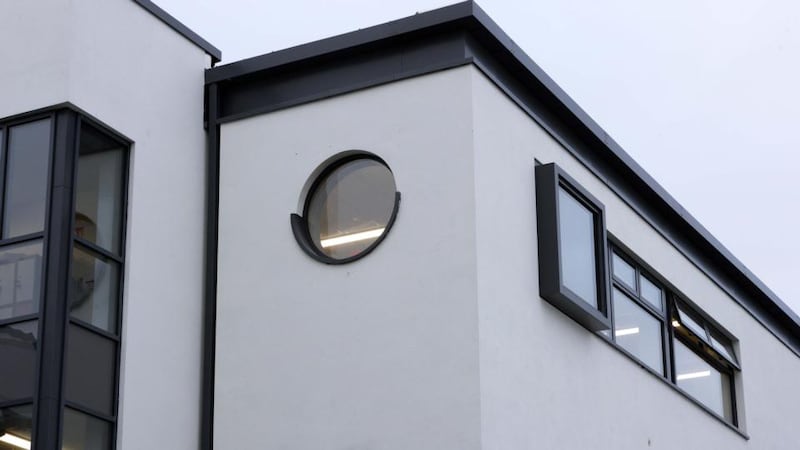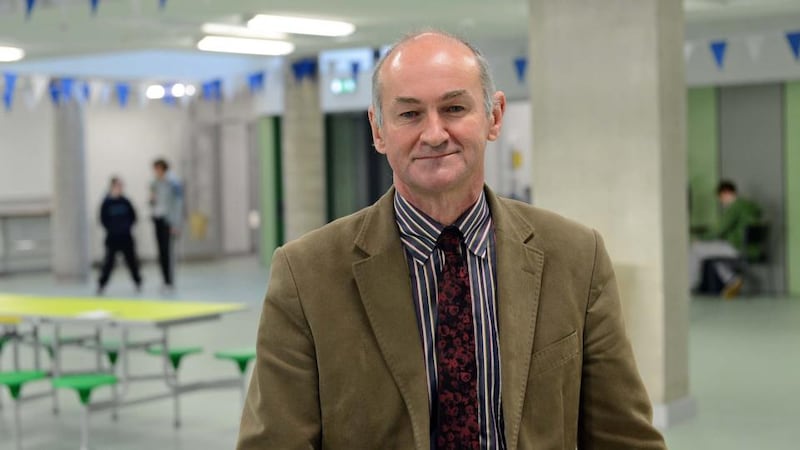It’s arguably the biggest challenge facing primary and secondary education, and it’s likely to be felt long after the current furore over the new junior cycle dies down. Between now and 2017, enrolments in primary schools and secondary schools will grow by, respectively, up to 45,000 and 25,000, and growth is expected to continue at that level until at least 2024. The Government has no choice, and no wriggle room: they have to provide new schools and, in many cases, dramatically improve existing ones.
At Newpark Comprehensive School in Blackrock in south Co Dublin, fifth year Juliette McBain is one of 849 students who last week moved from temporary prefabs into a new school building, funded by the Department of Education to the tune of €12.5 million. "We were in the prefabs for a year," says Juliette. "But those prefabs were a big improvement on what was there before. The old buildings smelled bad, the ceilings constantly leaked; it just wasn't a nice atmosphere to be in. It didn't reflect the students or the staff, but now it does."
Late last year, the then minister for education, Ruairí Quinn, announced 70 major school building projects as part of a €2 billion capital investment programme to be rolled out over five years. More than 40 school projects were completed in 2013.


In education circles, however, there has been some disquiet over rules and regulations about school design. The standard “schedule of accommodation” – which lists the type, number and size of spaces for a school and the technical requirements for each space – was overhauled last June. Too late for Newpark, which, in some respects, is already out-of-date.
Students with autism-spectrum disorders are now mainstreamed, but they weren't when the new school was designed, says Newpark's principal, Derek Lowry. "In the most recent Department of Education specifications for a new school, there would also be significant improvements to information technology," he adds. "These are not impossible obstacles, because the school will eventually have access to the refurbished Belfort House, which is on the school grounds and which housed an earlier, private Protestant school, and we will have wifi soon as well."
Other schools, however, may not be so lucky. In 2010, a report from the Economic and Social Research Institute highlighted the importance of school design for pupil engagement, learning and achievement. School and classroom density, class size, quality of lighting, ventilation and absence of noise were among the factors found to enhance the student experience. But generic designs remain commonplace.
Projected needs
In designing a new school or upgrading an old one, the p
lanning and building unit in the Department of Education works with the local school authority to determine the long-term projected enrolment for the school and its future curriculum. Certain elements, particularly in secondary schools, are mandatory: science labs, technology spaces, home economics rooms, spaces for art. Special needs, the length of the school week and the type of courses on offer (including transition year, the Leaving Cert Applied, the Leaving Cert Vocational Programme, and post-Leaving Cert courses) are all considered.
The Department of Education generally takes a pragmatic view and will work with schools. But it has also imposed generic designs for schools of different sizes, which, in some instances – such as in the case of Powerscourt National School in Enniskerry, Co Wicklow – have been poorly received by the local community.
If a school wants dedicated spaces for drama, music, extra sports or other creative or spiritual uses (such as a meditation room), the department generally doesn’t provide specific funding; in many cases, parents will fundraise for these.
An exception in Knocklyon
St Colmcille’s National School in Knocklyon, also in south Co
Dublin, is an exception. It was one of the largest school building projects in the history of the State. It opened its doors in September, and has 1,500 pupils, from junior infants to sixth class.
"In the mid-1970s, Knocklyon was provided with two 16-classroom schools next to each other, which mirrored schools from Portmarnock to Bray," says John Boyle, one of two principals at the school. "These schools looked the same, but they quickly proved too small. The choice for us became whether to limit numbers and ask some kids to go other schools, or expand."
As the area’s population grew, so did demand for school places. “The department offered a simple quadrupling of what a 16-classroom school would get: 64 classrooms, four PE halls, four libraries, two meeting rooms,” says Boyle. “We did fear the imposition of a generic design from the Department of Education.”
A concerted effort was made by the community, led by a locally-based architect, Louis Burke, to ensure this did not happen. But it required parents and teachers to make their voices heard.
In new or less well-established community, such as in Adamstown, where the school was planned before anyone moved into a house, generic designs are more common.
“We designed meeting spaces and breakout areas,” says Boyle. “We wanted to avoid the long corridors of some generically designed schools and to ensure that there was air and space. The department agreed to provide atria that would bring light and warmth to the building.”
The school also developed a roof garden, optimising the use of space.
"In general, the department's rules and regulations do not allow for 'wow' designs," says Sheila Nunan, general secretary of the Irish National Teachers’ Organisation.
"While the Department of Education is aware of the effect that better design will have on the school community, there are significant constraints posed by cost and compliance issues. The use of generic designs does not allow much flexibility for the provision of provocative or inspiring spaces. There is a need for a budget that incorporates new and innovative ideas." DRAMATIC TRANSFORMATION: NEWPARK'S BRAND NEW BUILDING Newpark Comprehensive School in Blackrock, south Co Dublin, was a first in Irish education: the first free secondary Protestant school, and the first "comprehensive" school, which means a focus on catering for all the different types of learners, from those with learning difficulties to high achievers. It was also one of the first schools in Ireland to pilot the transition year programme, and, arguably, the first to develop a unique and distinct ethos that focused on diversity, tolerance and creativity. It became well-known as a school with an emphasis on art, drama, music and sport, and it has a catchment area stretching from north Dublin as far as Wicklow.
It’s an ambitious school, and it might be one of the finest examples of the limited value of school league tables: although Newpark sends 66 per cent of students to third level, it has an emphasis beyond the purely academic, with a significant number of pupils with special needs and a focus on extracurricular activities.
The school, established in 1972, is also the site of the internationally renowned Newpark Music Centre, which has alumni such as Seán Carpio, recognised worldwide as one of the greatest living jazz drummers. The campus is also home to a sports centre with a swimming pool and gym.
The original school building was intended to last for 20 years. By the end of the 1990s, staff and students were using buckets to catch rainwater from the leaky roof. Gaping holes let draughts and rats inside. Students and teachers described the science labs as “disgusting”. Adult learners were deserting Newpark’s once-popular night courses.
“In 1999, we went to the Department of Education and said it had got beyond a joke,” says Derek Lowry, then deputy principal and now principal. “In fairness to them, they got on to it and appointed a design team in late 2000. It has taken a long time to get to this point, because it is a bureaucratic process and a lot has to be considered.”
Fifteen years does seem like a long time. Lowry explains that a proposed three-storey building in a residential area led to planning complaints. The school building programme was subject to cuts in 2003, which slowed the process further.
Of the school’s ethos, he says: “Part of the reputation was that we don’t push people. We do push people, but we push them in a way that recognises their individual talents, desires and abilities, which is aimed at developing their independence.”
The students’ enthusiasm is infectious. In the old school, the science labs were dirty and the taps only worked on occasion, says second-year student Tommy Tormey. “The old English room was so dull, dark and depressing,” he says. “The new room is so much lighter and brighter, which lifts everyone’s mood and makes learning much more enjoyable.”
Students recall being crammed into tiny corridors and having to factor in extra time to leave school. The new school, with a central atrium and lots of open and well-lit spaces, couldn’t be more different. The science labs, the metalwork room, the computer facilities are all gleaming, all state-of-the-art. A new art ceramics room will be used by students and adults in night classes. The opening-up of space increases curriculum possibilities.
Hot food caterers struggled to make a profit in the school’s old canteen, so the new building, although it has lunchroom facilities, sellsonly soup, sandwiches and wraps.
An art installation and a landscaping project are due to be finished in 2015.
“The new school belongs to the students,” says Lowry. “We gave the first tours to the student council, who in turn gave their classmates a tour. They must feel ownership.”












